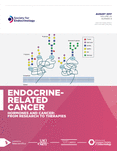Preclinical progress and first translational steps for a liposomal chemotherapy protocol against adrenocortical carcinoma
- Sara Jung1,
- Zoltan Nagy2,
- Martin Fassnacht3,4,
- Gerard Zambetti5,
- Max Weiss6,
- Martin Reincke1,
- Peter Igaz2,
- Felix Beuschlein1 and
- Constanze Hantel1⇑
- 1Endocrine Research Unit, Medizinische Klinik und Poliklinik IV, Ludwig-Maximilians-University, Munich, Germany
- 22nd Department of Medicine, Semmelweis University, Faculty of Medicine, Budapest, Hungary
- 3Department of Internal Medicine I, Division of Endocrinology and Diabetes, University Hospital, University of Würzburg, Würzburg, Germany
- 4Comprehensive Cancer Center Mainfranken, University of Würzburg, Würzburg, Germany
- 5Department of Pathology, St Jude Children’s Research Hospital, Memphis, Tennessee, USA
- 6Institute of Pathology, Ludwig-Maximilians-University, Munich, Germany
- Correspondence should be addressed to C Hantel; Email: Constanze.Hantel{at}med.uni-muenchen.de
-
Figure 2
Immunohistochemical and histological analysis of SW-13 (A, B and E) and SJ-ACC3 (C and D) xenografts derived from the short-term therapeutic experiment with quantification of Ki67-positive, Ki67-negative (A and C) and TUNEL-positive cells (B and D). Necrosis was analyzed semi-quantitatively using four categories ranked in ascending order from 0 (no necrosis) until 3 (extensive necrosis) for each SW-13 tumor, respectively (E). Representative pictures from Ki67 (F–I) and H&E staining (J–M) are presented for NaCl (F and J), EDP-M (G and K), LEDP-M (H and L) and L(l)EDP-M (I and M)-treated SW-13 tumors. Statistical significance vs controls is denoted as stars (*P < 0.05; **P < 0.01; ***P < 0.001).
-
Figure 3
Effects on tumor size of SW-13 (A) and SJ-ACC3 (B) xenografts after two therapeutic cycles with the different treatment modalities. Statistical comparisons were performed using a one-way ANOVA followed by Bonferroni’s Multiple Comparison Test (compare all groups). Stars (*P < 0.05; **P < 0.01; ***P < 0.001) denote significant differences compared with controls, comparisons to other treatment groups were not significant (P > 0.05). SW-13 tumor-bearing mice that received up to four therapeutic cycles of NaCl, EDP-M, LEDP-M or L(l)EDP-M treatment were killed after achieving pre-defined endpoints. Regarding the achievement of study termination, the comparison of all treatment groups resulted in significant differences using a log-rank (Mantel-Cox) analysis. Significant differences are illustrated in (C) in comparison to L(l)EDP-M. Individual reasons for study termination are furthermore depicted in (D).
-
Figure 5
Quantitative real-time PCR analysis of intratumoral and circulating miR 483-5p (A) and miR-210 (B) of control (NaCl) and LEDP-M-treated SW-13 and SJ-ACC3 tumor-bearing mice. For analysis of changes upon therapeutic treatment in individual animals, the ratio of intratumoral to circulating miR level was calculated after normalization to controls. A value of 1 indicates unchanged equal levels in tumor and plasma. A value of >1 reveals an elevated expression of intratumoral miR, whereas a ratio of <1 indicates elevated expression of circulating miR. Stars denote significant differences (*P < 0.05).
- © 2016 Society for Endocrinology












